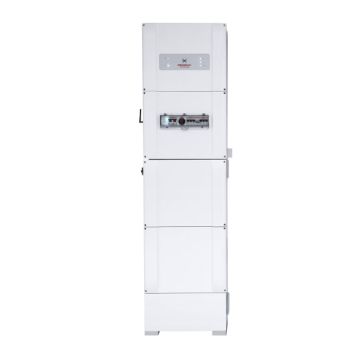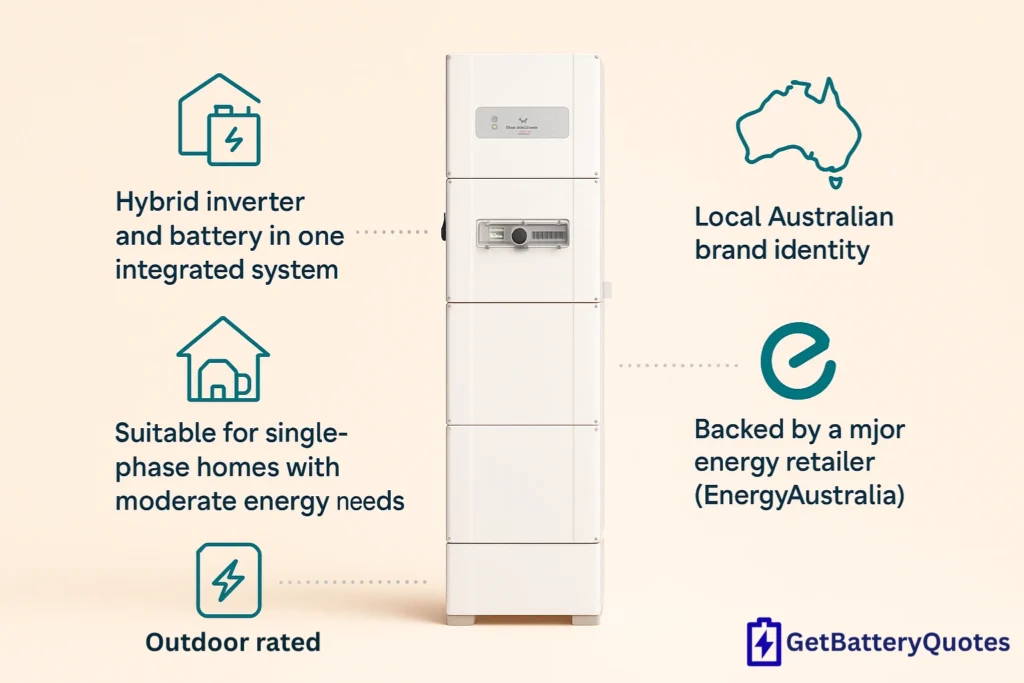Table of Contents
- 1. Is the Redback Smart Battery a Good Choice in 2025?
- 2. Quick Pros & Cons
- 3. Redback Battery Performance Matrix
- 4. Is the Redback Battery Right for You?
- 5. About Redback Technologies
- 6. Redback Battery Model Range (CEC Approved)
- 7. Key Technical Specifications
- 8. Expanded Pros & Cons
- 9. Support & Warranty
- 10. Ask Us Anything
- 11. Downloadable Documents
- 12. Final Verdict: Should You Buy a Redback Battery in 2025?
Is the Redback Smart Battery a Good Choice in 2025?
Redback Technologies is one of the few Australian-founded companies in the solar battery space. Headquartered in Brisbane and backed by Energy Australia since 2016, Redback promotes itself as a provider of smart solar storage solutions designed for local homes.
Their current product range includes the Smart Battery series (SB9600 and SB14200) and the newly approved RED-R1 modular system. With usable storage capacities from 4.8 kWh to 12.78 kWh, Redback’s solutions combine hybrid inverters, lithium-ion battery modules, and monitoring software into one package.

Quick Pros & Cons
Pros
- Australian-founded brand with EnergyAustralia backing
- Outdoor-rated Smart Battery systems available
- Modular storage up to 19.2 kWh
- Integrated hybrid inverter and battery design
- Remote access via MyRedback app and web portal
Cons
- 10-year warranty (shorter than 15 years offered by Tesla or Enphase)
- Mixed installer and customer reviews in Australia
- MyRedback app considered less polished than competitors
- Brand presence smaller than global leaders
- New RED-R1 system is indoor-only and unproven in market
Redback Battery Performance Matrix
Technical Performance
Perfomance
0%
Scalability
0%
Backup & Compatibility
0%
Summary:
Decent modular capacity and inverter integration, but less proven than global leaders.
User Experience
Ease of Installation
0%
Smart Features & App
0%
Customer Reviews
0%
Summary:
Installer-friendly hybrid setup, but app experience and long-term reliability lag behind rivals.
Trust & Support
Value for Money
0%
Warranty & Support
0%
Brand Presence in Australia
0%
Summary:
Local brand with backing, but warranty terms and customer support feedback remain weaker.
Overall Score
65%
65%
Best suited for households looking for a locally designed option with integrated hybrid inverter features, but not among the top-recommended batteries in 2025.
Get Upto 3 Quotes
Compare Battery prices from trusted installers and save thousands on your energy storage system

Is the Redback Battery Right for You?
The Redback Smart Battery may suit:
- Homeowners who want an all-in-one inverter and battery system
- Those preferring an Australian-founded brand with local presence
- Households needing outdoor-rated storage between 9.6 kWh and 14.2 kWh
- Users comfortable with moderate app features and EnergyAustralia support
It is not ideal for buyers seeking the highest reliability, longest warranty, or polished app experience.
About Redback Technologies
Redback Technologies is based in Brisbane, Australia, and focuses on designing smart solar storage systems for residential and small business use. Founded in 2015, the company has been supported by EnergyAustralia, one of the country’s largest energy retailers.
The company is best known for the Redback Smart Hybrid System, which integrates an inverter, battery modules, and monitoring into a compact cabinet.
Redback Battery Model Range (CEC Approved)
| Model | Type | Nominal Capacity (kWh) | Usable Capacity (kWh) | Outdoor Rated | Status |
|---|---|---|---|---|---|
| SB9600 Smart Battery | Integrated BESS | 9.6 | 8.64 | Yes | Approved until Nov 2025 |
| SB14200 Smart Battery | Integrated BESS | 14.2 | 12.78 | Yes | Approved until Nov 2025 |
| RED-R1-5000LV | Battery System | 5.12 | 4.864 | No (indoor only) | Approved until Aug 2028 |
Key Technical Specifications
- Battery Type: Lithium-ion (Li-ion)
- Chemistry: LFP (Lithium Iron Phosphate)
- Storage Capacity: 9.6–19.2 kWh (Smart Battery), 5.12 kWh (RED-R1 module)
- Usable Capacity (CEC): 8.64 kWh (SB9600), 12.78 kWh (SB14200), 4.864 kWh (RED-R1)
- Inverter Output: 5 kVA (SH5000-G3), 6 kVA (SH6000-G3)
- Max PV Input: 8,000–9,600 Wp depending on model
- Charge/Discharge Power: 5–6 kW
- Monitoring: MyRedback app + Redback Portal
- Communications: Bluetooth, Wi-Fi, Ethernet, optional 4G
- Dimensions: 540 x 363 x 1990 mm (cabinet system)
- Warranty: 10 years
Expanded Pros & Cons
Pros
- Hybrid inverter and battery in one integrated system
- Suitable for single-phase homes with moderate energy needs
- Outdoor-rated Smart Battery models available
- Backed by a major energy retailer (EnergyAustralia)
- Local Australian brand identity
Cons
- Warranty is shorter than leading competitors (10 years vs 15–20 years)
- App features less intuitive than Tesla or Enphase
- Mixed reviews on customer support and reliability
- RED-R1 modular battery is indoor-only and yet to prove itself in market
- Smaller installer network compared to global brands

Get Upto 3 Quotes
Compare Battery prices from trusted installers and save thousands on your energy storage system
Support & Warranty
- Warranty: 10 years on batteries, which is now considered standard but not best-in-class
- Support: Available through Redback Technologies and EnergyAustralia channels
- Reliability: Field performance is mixed, with some installers reporting smooth installs and others citing challenges with support response times
We Have Great Answers
Ask Us Anything
Redback Technologies is an Australian company headquartered in Brisbane. Since 2016, it has been backed by EnergyAustralia, one of the country’s largest energy retailers.
They are best known for the Redback Smart Hybrid System, which combines an inverter, lithium battery modules, and monitoring software into one unit.
For installers, the hybrid cabinet design is straightforward. However, compatibility is narrower than BYD or Sungrow, and commissioning depends on the MyRedback app.
Yes, Redback Smart Batteries can provide backup power, but the capacity and duration depend on the chosen model and load.
A dedicated home battery like Tesla Powerwall or BYD remains more proven for whole-home backup. Redback can support essential loads but is less established.
A Redback Smart Battery (12.78 kWh usable) might run an efficient household for 6–12 hours, depending on consumption.
For many Australian homes, 10 kWh covers evening and overnight usage, but households with high consumption may need more capacity.
No, solar panels do not draw energy at night. Batteries only discharge when powering household loads.
Redback batteries are low maintenance. Occasional firmware updates and monitoring are required, but no regular servicing.
Excess solar is exported to the grid or curtailed if export limits apply.
Most panels need cleaning once or twice per year, depending on dust and debris.
Payback depends on energy usage, tariff rates, and rebates. Redback systems may offer a longer ROI period than market leaders due to their warranty and support limitations.
Downloadable Documents
Final Verdict: Should You Buy a Redback Battery in 2025?
Redback Technologies offers an Australian-designed solution with integrated inverter and battery features. While the systems are flexible and locally supported, their shorter warranty, mixed reviews, and smaller market presence hold them back.
Overall Score: 65%
Technical Perfomance
0%
User Experience
0%
Trust & Support
0%
The Redback Smart Battery may suit households wanting a locally branded all-in-one system with moderate capacity, but stronger and more proven options are available in 2025 for most Australian homeowners.


